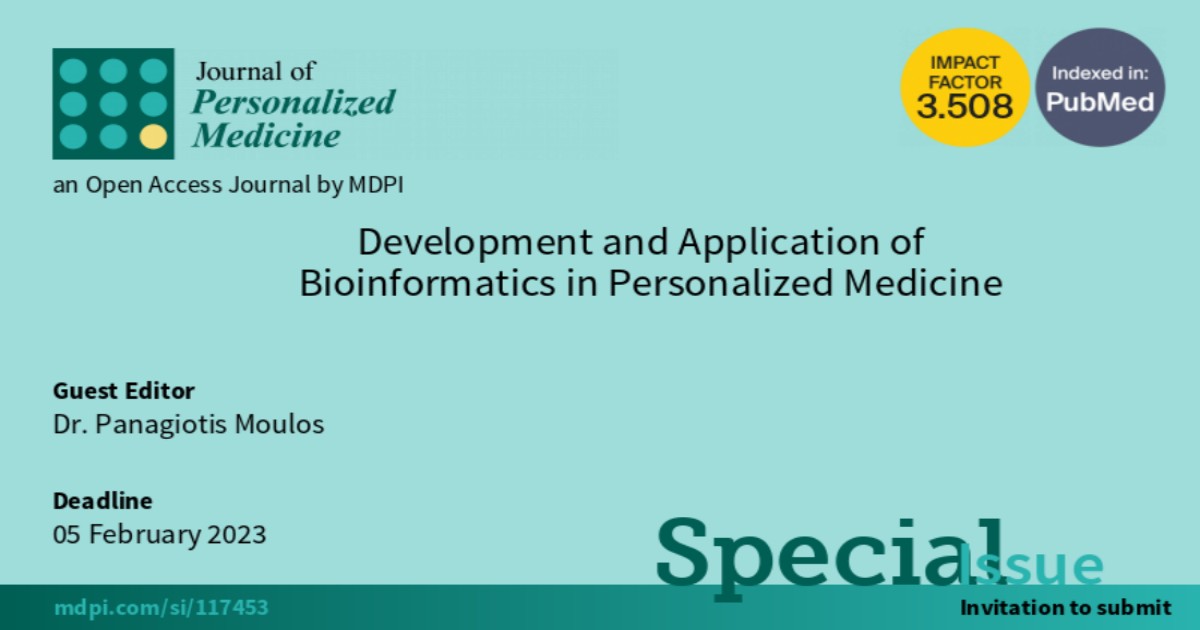Development and Application of Bioinformatics in Personalized Medicine
A special issue of Journal of Personalized Medicine (ISSN 2075-4426). This special issue belongs to the section "Omics/Informatics".
Deadline for manuscript submissions: closed (5 February 2023) | Viewed by 8995

Special Issue Editor
Special Issue Information
Dear Colleagues,
We live in the era of personalized medicine where technological advancements provide the means to systematically and holistically investigate the human genome and use the findings towards better healthcare and well-being. Such advancements in combination with vast amounts of research data accumulated over the past couple of decades offer unique opportunities for breakthrough discoveries through Bioinformatics which is the realization of Data Science in Life Sciences. Furthermore, technological breakthroughs in genomics such as Next Generation Sequencing (NGS), proteomics, metabolomics, and other -omics techniques have boosted the domains of Clinical -omics – the combined investigation of the human genome, proteome, and metabolome for clinical applications – and as a result, the emergence of Clinical Bioinformatics is prevalent.
We are pleased to invite you to submit papers with the results achieved with the application of bioinformatics personalized medicine approaches, including but not limited to the single and/or combined usage of -omics techniques. Articles presenting state of the art methodological aspects such as new algorithms and software focusing on and promoting personalized medicine and healthcare are welcome.
This Special Issue aims to familiarize researchers in basic and applied research, as well as physicians with the latest advances in applying bioinformatics to promote and improve personalized medicine, approaches taking advantage of modern high resolution -omics data.
In this Special Issue, original research, methodological and software articles, and reviews are welcome. Research areas may include (but not limited to) the development and utilization of bioinformatics approaches for the following:
• Personalized treatments
• Development of molecular disease signatures
• Disease-specific -omics databases
• Disease-specific knowledge and biomarker databases
• Multi-omics integrations for disease characterization and treatment
• Discovery of single or multi-omics disease biomarkers
• Big -omics data for personalized medicine
• Imaging techniques and analysis for personalized treatment
• Algorithms for -omics data analysis and integration with the goal of providing personalized treatments
• Scientific software centered around personalized medicine and treatment
• Single-cell -omics and bioinformatics for personalized medicine
• Development of Polygenic Risk Scores related to disease
• Pharmacogenomics, pharmacoproteomics, and pharmacometabolomics
We look forward to receiving your contributions.
Dr. Panagiotis Moulos
Guest Editor
Manuscript Submission Information
Manuscripts should be submitted online at www.mdpi.com by registering and logging in to this website. Once you are registered, click here to go to the submission form. Manuscripts can be submitted until the deadline. All submissions that pass pre-check are peer-reviewed. Accepted papers will be published continuously in the journal (as soon as accepted) and will be listed together on the special issue website. Research articles, review articles as well as short communications are invited. For planned papers, a title and short abstract (about 100 words) can be sent to the Editorial Office for announcement on this website.
Submitted manuscripts should not have been published previously, nor be under consideration for publication elsewhere (except conference proceedings papers). All manuscripts are thoroughly refereed through a single-blind peer-review process. A guide for authors and other relevant information for submission of manuscripts is available on the Instructions for Authors page. Journal of Personalized Medicine is an international peer-reviewed open access monthly journal published by MDPI.
Please visit the Instructions for Authors page before submitting a manuscript. The Article Processing Charge (APC) for publication in this open access journal is 2600 CHF (Swiss Francs). Submitted papers should be well formatted and use good English. Authors may use MDPI's English editing service prior to publication or during author revisions.
Keywords
- bioinformatics
- personalized medicine
- clinical genomics
- clinical proteomics
- clinical metabolomics
- clinical genetics
- algorithms
- software
- disease signatures
- pharmacogenomics






